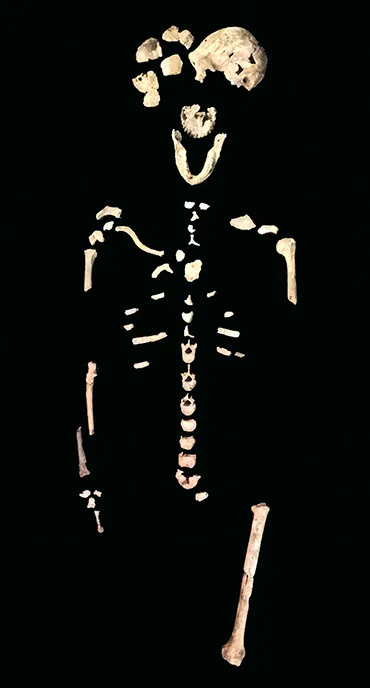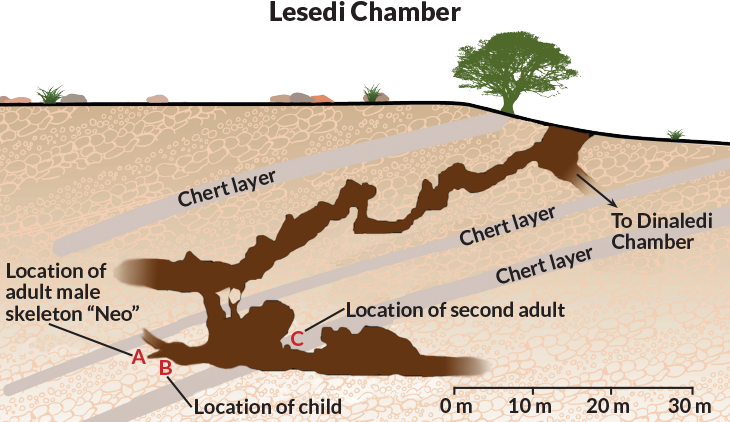Homo naledi may have lived at around same time as early humans
New dating puts famed hominid in South Africa as recently as 236,000 years ago

NALEDI’S FACE Excavations in an underground cave in South Africa produced new Homo naledi fossils, including this skull of an adult male. H. naledi fossils in a nearby cave may be as young as 236,000 years old, raising questions about how human evolution occurred.
Wits Univ., J. Hawks
Fossils of a humanlike species with some puzzlingly ancient skeletal quirks are surprisingly young, its discoverers say. It now appears that this hominid, dubbed Homo naledi, inhabited southern Africa close to 300,000 years ago, around the dawn of Homo sapiens.
H. naledi achieved worldwide acclaim in 2015 as a possibly pivotal player in the evolution of the human genus, Homo. Retrieved from an underground chamber in South Africa, fossils of this species were thought to be anywhere from 900,000 to at least 1.8 million years old (SN: 8/6/16, p. 12). A younger age for H. naledi resolves one mystery about these cave fossils. It doesn’t, however, answer questions about how long ago the species first appeared and when it died out.
What is now known is that H. naledi bodies somehow ended up in Dinaledi Chamber, part of South Africa’s Rising Star cave system, between 236,000 and 335,000 years ago, an international team reports in one of three papers published May 9 in eLife. Paleoanthropologist Lee Berger of the University of the Witwatersrand in Johannesburg headed the team. Geoscientist Paul Dirks of James Cook University in Townsville, Australia, directed the dating effort.

In a second new paper, Berger’s group — led by paleoanthropologist John Hawks of the University of Wisconsin–Madison — describes 131 newly discovered H. naledi fossils from a second underground cave, dubbed Lesedi Chamber, within the Rising Star cave system. The finds come from at least three individuals and include an adult male’s partial skeleton comparable in completeness to Lucy’s famous, 3.2-million-year-old remains from East Africa. Both of these specimens consist of about 40 percent of the skeleton. The researchers named the Lesedi partial skeleton “Neo,” which means gift in Sesotho, a language spoken in South Africa.
Berger and his colleagues say the Lesedi discoveries support their controversial suggestion that H. naledi deliberately put bodies of the dead in Rising Star’s underground chambers (SN: 5/14/16, p. 12). The team says there are no signs that either predatory animals or streams carried H. naledi corpses into the caves.
Individuals from both underground chambers display the same distinctive pattern of skeletal features, signs that they all belong to H. naledi, not to Homo erectus or any other previously identified Homo species, the investigators contend. These features include relatively small, orange-sized brains and curved fingers like those of Homo species that lived around 2 million years ago, as well as wrists, hands, legs, feet and body sizes comparable to those of Neandertals and humans.
Although the Dinaledi finds are unexpectedly young, H. naledi’s ancient-looking characteristics suggest that the hominid originated near the root of the Homo genus, 2 million years ago or more, Berger and colleagues propose in the third new paper. That would make the South African species a possible ancestor or close relative of H. erectus, which dates to around that time. The oldest Homo fossils date to 2.8 million years ago in East Africa (SN: 4/4/15, p. 8).
Another possibility, Berger’s group says, is that H. naledi originated a few hundred thousand years ago and is most closely related to early H. sapiens or other Homo species that may have inhabited southern Africa at that time. A relatively late origin for H. naledi would suggest it evolved from larger-brained ancestors, the researchers say. That would be unusual: Scientists have long held that the brain only became larger as Homo species evolved.
But that proposed scenario has some parallels to Indonesia’s Homo floresiensis, better known as the hobbit. These hominids, whose remains date to between about 100,000 and 60,000 years ago (SN: 4/30/16, p. 7), had chimp-sized brains, short statures and, like H. naledi, some skull features resembling early Homo species. Hobbits either evolved smaller brains or retained small brains after splitting from a much older Homo species in Africa.
Unlike H. naledi, hobbits lived on an island where a lack of competition with other Homo species may have assisted their survival. It’s unclear how H. naledi survived in Africa alongside larger-brained Homo species, perhaps even H. sapiens. Occasional interbreeding in southern Africa — similar to what occurred later among H. sapiens, Neandertals and Denisovans in Eurasia (SN: 10/15/16, p. 22) — may have benefited H. naledi, Berger’s team suspects.
Story continues after graphic
Fossil chamber
A narrow, sometimes treacherous path took Rising Star cave explorers from the surface to the Lesedi Chamber in South Africa. Homo naledi fossils excavated there come from at least three individuals, including an adult male that the investigators named Neo. An adjacent, belowground passageway connects to the Dinaledi Chamber, where H. naledi fossils were first unearthed.

H. naledi DNA would help clarify the species’ evolutionary status. But attempts to extract DNA from Dinaledi fossils have so far failed. Researchers have yet to test Lesedi fossils for DNA or to try to generate age estimates for the new finds.
“My intuition is that Homo naledi points to a diversity of African Homo species that once lived south of the equator” in Africa, Hawks says. It’s unlikely Homo evolution proceeded in a straight line, from one species to the next, in a specific part of subequatorial Africa, he proposes.
Paleoanthropologists familiar with the new reports interpret the findings differently.
An “astonishingly young” age for a Homo species with several ancient-looking features suggests H. naledi was the sole survivor of an array of much older, closely related species, proposes Chris Stringer of the Natural History Museum in London. H. naledi probably made some of the many stone tools found at southern African sites dating to around 300,000 years ago that have not yielded hominid fossils, he adds. But despite Berger’s claims, Stringer doubts a creature with a brain size close to that of a gorilla disposed of its dead deep within a pitch-black, hard-to-navigate cave system, especially since the controlled use of fire for torches was probably also needed.
Berger’s team plans to excavate near openings to the Rising Star cave system where stone tools and signs of fire use may turn up.
However complex H. naledi’s behavior may have been, ancient aspects of its anatomy rule it out as an ancestor of H. sapiens, says Donald Johanson of Arizona State University in Tempe. Johanson, codiscoverer of Lucy, argues that H. sapiens originated in East Africa. Researchers generally place that evolutionary turning point, wherever it occurred, at between 200,000 and 300,000 years ago. “The Rising Star Cave hominids, much like the hobbits, evolved in isolation and have no relevance to the origins of humankind,” Johanson says.
Still, even a largely isolated H. naledi population may have occasionally interbred with other Homo species in southern Africa, says Fred Smith of Illinois State University in Normal. Later Homo evolution “is far more complex than has generally been thought,” he says.
Berger and his colleagues second that point.







